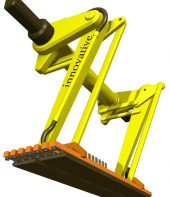What gives you pride?
The Elegant Design
What defines “elegant”? Refined, graceful, dignified, precise, and effortless beauty - a powerful descriptive combination. Typically one would think of elegance as a way to describe a luxury car or a charter jet or a house of the rich and famous. Usually it is thought of as a visual attribute, a feeling we get when we see something “elegant”. But what about in the world of mechanical design? What is it that an engineer strives for? What do they see as “elegant”?
| As my father always says "Nobody has time to do it right but everybody has time to do it again". I try not to be everybody. |
To me an elegant design is one which, to the lay man, looks simple. The moving parts are minimized, the structure components are sleek and streamline, and there is continuity in the motion of the automated system – smooth yet firm, graceful but powerful. It is a design where all of the components are working together and every possible glitch has been avoided. There lies the complication. We have all seen a machine that is assembled using a thousand parts from our favorite automation parts supplier where everything is modular off-the-shelf components “designed” to accomplish a task. Does this work? Yes. Is it cheap? Initially. Is it elegant? No. Although all of the individual components are readily available at a price that we like the final cost can be anything but cheap. Debugging is expensive. Down time and repairs are very expensive. Re-designing the machine because the crude assembly of parts does not function properly is extremely expensive. This approach only works well when the components suit the application and considerations to reliability and debugging are considered up-front.
Elegance in design is not limited to a moving assembly - even a single, static part can be designed such that it is considered elegant. A prime example is an upright for a race car. Through analysis and testing an upright is refined to maximize strength and minimize weight. It looks natural to the point of looking organic. Amazing.
In order for an elegant design to be born, you need two things: dedication and creativity. Most designs start off as a bunch of building blocks all stuck together to solve a problem or to complete a task – and for many projects this is all that is necessary. Why would you build a yacht to cross the river when a canoe will do? But for other projects where more is required – such as weight savings, or increased efficiency, or decreased costs, or increased reliability – refinement of the building blocks are necessary. All these start the design down the creative path. The path where elegance is found.
Often it is a “eureka” moment that gives the design the final bump. Sometimes it is from excessive and iterative refinement. Either way the end result has transformed from a “mechanical design” to “mechanical art”. It is something that when put into operation is mesmerizing and intriguing. It is perfect. It is elegant.
This is what engineers strive for. This is what gives us pride.
This article was authored by Dan Gray. Mr. Gray is a mechanical engineer who has been with Applied Kinetics since 2007. He has great hands on and practical experience from previous job placements and from having a "farmers" upbringing.



